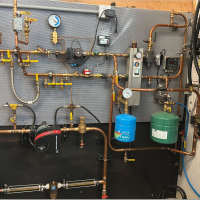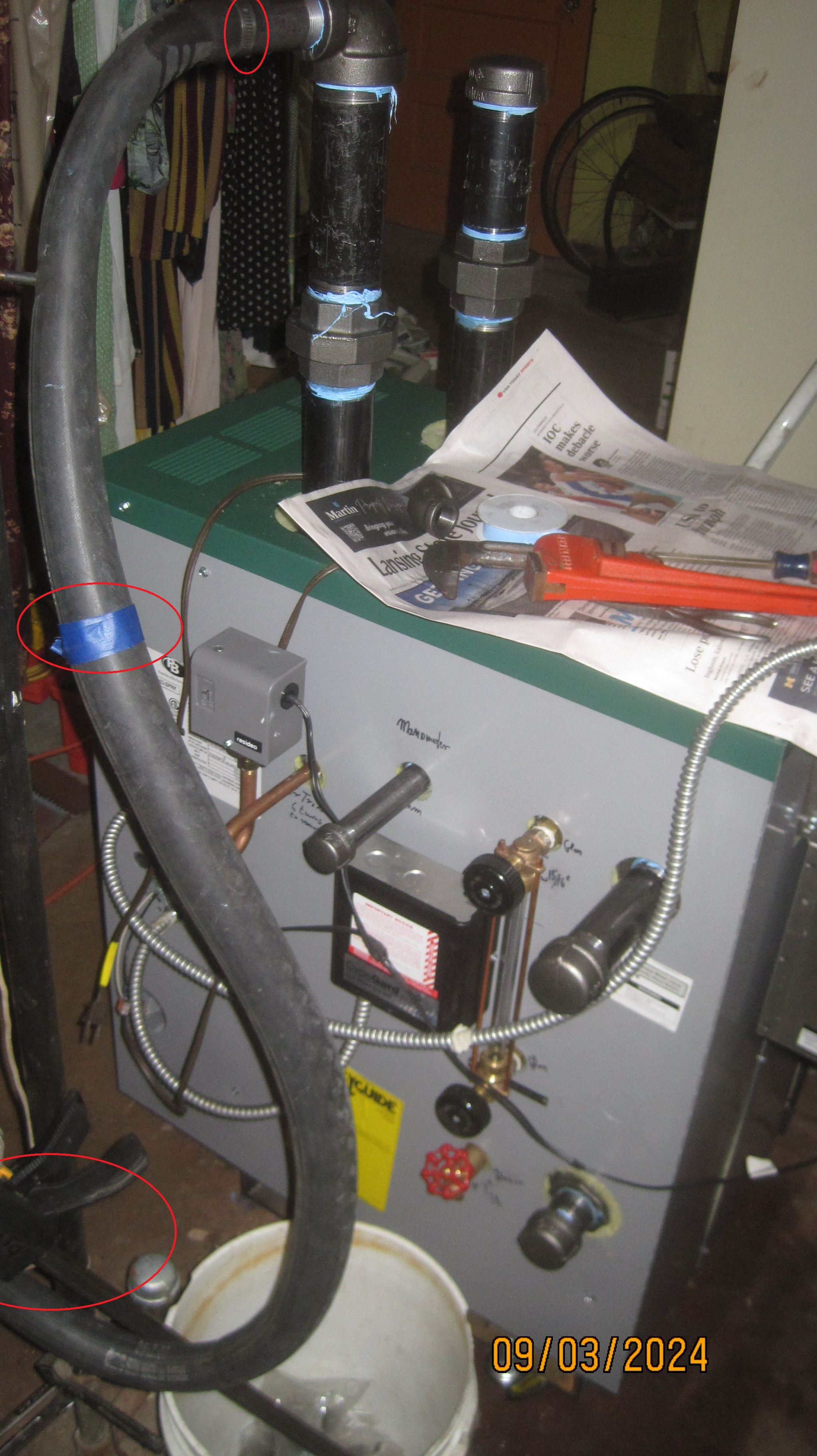New boiler: hydrostatic pressure test
The manual for the Weil-McLain WGO-3 oil boiler says to to a hydrostatic pressure test before installing it. Do people really do it? I don’t have a pump, though I thought maybe there’s a way to do it hooking up to my domestic water which will be pressurized to 30/50 psi, and turning it off when the mounted pressure gauge says 30. Also I don’t have 1-1/2” plugs for supply and return. I’ve heard that the distributor might supply those, but it’s not listed. (Boiler’s not here yet).
Comments
-
If you're serious @Revenant, and I assume you are (@EdTheHeaterMan once taught me a very handy trick using a bicycle pump with a few fittings, so I have one…) I guess I'd find the right fittings to hook it up to the drain valve hose connection.
I thought it might be easier to tap into my domestic water and fill it from that from the drain until the boiler gauge says 30 psi, but that sounds too easy and maybe there's a problem with that method — does anybody do that?
Mostly I am curious does anybody really stop before installing to do this test on a new boiler? (I'm wondering if it's one of those things nobody really does, although then you'd be owning up to it on this forum…)
0 -
I would not use water to pressurize; that will give a lot more pressure than you'll ever get in operation.
I did this test on my new boiler with a bicycle inner tube cut open, slipped over a nipple attached to the boiler, and rolled up and clamped with a bar clamp on the far side of the valve. I then pumped the inner tube up — it was a good-size mountain-bike one, for volume — and went to town with soapy water and a brush, aka bubble test. I did find one place where the piping leaked, but only slightly, and that was where I'd deliberately left off the Teflon tape. Even so, it held pressure for a good half hour.
I have a picture somewhere; it looked pretty janky but it worked.cheers -m
0 -
I do not think that I ever did a hydrostatic pressure test on a boiler before installing it. That test will automatically happen when I go to fill it with water the first time. The test needs to happen in order to verify the boiler is not leaking from the factory. After you place the fittings and the pipes that connect it to the system, you add water and look for leaks. I have had many leaking fittings over the years. Forget to tighten a pipe with a pipe wrench, incomplete cleaning of a solder joint, the packing nut on a valve. Only once did a boiler section leak, and I didn’t find that until the following year, when I opened the front boiler door on the annual first maintenance.
How did I get my customer to get an annual service on a brand new boiler you ask?
For those of you installing new systems for customers, I added about $100.00 to the price of the job to include the first tune up at the end of the year. (today’s tune ups are more expensive, I'm sure) The customer saw that when they purchased the system. First annual tune up at no charge is included. That gets you into the home to offer them an annual service/maintenance agreement at the end of the first year. (when the competition’s warranty ends) Many parts have 3 to 10 year warranty from manufacturers when the warranty is registered, So I tell them that if they want this same service next year, all they need to do is sign up today for the maintenance agreement (usually the lower cost agreement) for $$$ for the year or $$ per month, and I will extend the factory parts coverage along with our company's labor coverage for another year. Signed up a lot of service agreements that way.Edward Young Retired
After you make that expensive repair and you still have the same problem, What will you check next?
2 -
It is normal on commercial jobs to pressurize a boiler to 1 1/2 x the max working pressure which is 15psi for steam and usually 30 psi for hw. so 22 psi is enough for steam and 45 for water.
The pressure can come from the city water if the CW pressure is high enough. Your supposed to fill the boiler with water and no air you vent all air from the boiler.
Pressurizing with is under compression is dangerous if the boiler comes apart it is like an explosion. Using water which cannot be compressed is the safer way.
0 -
This is a pretty lousy picture of my test setup. I don't know what the pressure is — My guess is a pound or two at most — but it lets you check for leaks in your piping with soapy water, and will tell you if the whole thing is tight.
The circled features are a hose clamp to seal at the boiler piping, a wrap of masking tape to show you if the tube is shrinking, and a bar clamp to seal the far end of the inner tube. I found it a useful exercise that gave me confidence to move forward. A pro would probably just not worry about it.
cheers -m0 -
AI claims the boilers are factory tested
Bob "hot rod" Rohr
trainer for Caleffi NA
Living the hydronic dream0 -
-
#trustbutverify
0 -
-
We had a used HP boiler (250psi steam) the customer owned that they shipped into MA from CA. It had been partially disassembled to ship. We assembled it and had a certified hydro test done on it which it passed. After it was rigged into the boiler room and set in place the inspector made us have it hydrotested again. Easch test was like 3k
0 -
Okay, my guess is that this is the kind of thing that's mentioned in a manual and nobody actually does it in real life, at least in residential, and that this is a case of "only a novice would pay attention to that."
But I think I see why they at least say they want you to test before install: if you ran it after installation and it didn't hold pressure, that leak could be anywhere in the system. Might be easy to track down, might not. If you didn't find a leak in your piping or some device, you'd now have to uninstall the near boiler piping to test the isolated boiler.
So, in case I decide to do this, I ordered two 1-1/2" plugs and a 3/4" plug for the tappings ($15.00 tal at HD), if I use them I'd have a pair of attractive paperweights or doorstops, if I don't, or the manufacturer includes them with the boiler, I can return them. My plan is, when the boiler is in the garage (it's eventually going into the next room, the basement), with the tappings plugged except for the supply (to vent air) run a garden hose with a washer hose attached from the outside hose bibb to the boiler drain and fill until water comes out the top. Then plug the supply and reopen the drain with washer hose attached to keep filling until the installed boiler gauge says 30 psi, the manufacturer's recommended 1-1/2 times working pressure (taking the latter as 20 psi). Then close the drain and wait the ten minutes they recommend. Only thing is, I'd have to drain the whole thing afterward; I do not want to move and lift that thing onto blocks with any extra weight in it.
(@Revenant, bicycle pump sounds like a good idea, but I'd have to hunt down an appropriate something-to- 3/4 female hose adaptor, and also do a bunch of pumping. I'd have the hose there anyway to fill the thing, this way I'd just be filling it to the desired pressure. If it works.)
For the record, here's what it says in the WGO manual, followed by AI's take on using domestic water. One thing I don't understand is WM says to remove the relief valve but says only to plug the supply and return tappings; I assume I'm supposed to plug the now open relief valve elbow too.
(AI says use water over 70 degrees but WM doesn't. My water will be cold. But I guess if I wanted to I could run hot water via the garden hose from a drain I have on the supply side of the hot water heater.)
Weil-McLain: Perform hydrostatic pressure test1. Remove relief valve installed in boiler.2. Install air vent in “N” tapping on top boiler.3. Plug supply and return tappings.4. Drain valve is already factory-installed.5. Fill boiler. Vent all air. Pressure test boiler at 1½times working pressure.Do not leave boiler unattended. Coldwater fill can expand and damage castiron, resulting in severe personal injury,death or substantial property damage.6. Check for maintained gauge pressure for morethan 10 minutes. Visually check for leaks if gaugepressure drops.7. Drain boiler. Repair leaks if found.
AI:
Yes, a boiler can be hydrostatically tested using domestic water pressure. Hydrostatic testing is a non-destructive way to check for leaks and ensure the integrity of a boiler:
- Fill the boiler with water
- Pressurize the boiler to at least 1.5 times its maximum operating pressure
- Monitor the boiler for a set amount of time to ensure the pressure doesn't drop
- Inspect the boiler for leaks, bulging, or seeping
Here are some tips for performing a hydrostatic test:
- Use water with a temperature between 70°F and 120°F
- Vent all air from the boiler while filling it
- Fill the boiler until water overflows the vent, then close the vent
- Use the appropriate pressure testing equipment, such as pumps, gauges, and hoses
- Follow safe operating procedures and wear the required personal protective equipment
0 -
The adapter for air pressurizing is easy to find on Amazon, search for "RV blowout adapter." Lots of choices. You can get them with either a Schrader valve for using a bicycle pump or a quick-connect for using a compressor.
0 -
Thanks @DCContrarian that would be just the thing.
0 -
-
Point well taken @delcrossv. So after reading @Revenant’s comments it really drove home that for all my angst about moving this thing and getting it up on blocks and if I can’t then calling some plumber or somebody for rescue, that worse come to worse I could disassemble it (it will be prepackaged) and put it together. I will have to make that decision in the garage - if I can move it around with the hand truck and tilt it back enough for someone to slip a block under then I’ll know I’m good. If I dis- and re-assemble I’ll do the pressure test after. I really don’t want to take it apart and put it back together though. More time and chance for user error.
0 -
I was scared to death I'd crack a connection. Given that Peerless boilers have push nipples, I probably could have tumbled it down the stairs and been OK…
My install thread describes in some detail how I did it.
The best tool would be a motorized dolly with separate motors for the wheels and the load. Youtube shows it well (search "motorized stair dolly"). Mine did not allow me to raise the load independently, and I couldn't use it to go down the basement. All is well that ends well. With another strong person, I might have managed but it was too much weight for me to counterbalance.0 -
@mattmich yes, your thread helped initially inspire me that maybe I could do this. My task is nowhere near as complex as yours was. I do not have any stairs to deal with. A few corners due to an old car that can't be moved, but level all the way (except for getting up on blocks). Your system is steam, none of which I understand; mine in comparison is a hot brick with some tubes coming out of it (though not really, an oil heat hydronic system is complex). Boiler's coming today, appliance hand truck is rented. Though it smacks of Instagramism and Faecebookism, I think I'll start a new thread documenting my progress (briefly, I hope). Really it'll be a vehicle for my panicked questions.
1 -
-
-
Just found this thread! I was just reading the manual for our Weil-McClain CGa4 and it says to attach the circulator as part of the test?
0 -
-
@neilc why would 2 of these not leat you roll it wherever you wanted it on a single level?
https://www.homedepot.com/p/Milwaukee-1-000-lbs-Capacity-Poly-Furniture-Dolly-DC73730/207155059
these are good for nudging around large heavy objects too
0
Categories
- All Categories
- 87.4K THE MAIN WALL
- 3.2K A-C, Heat Pumps & Refrigeration
- 61 Biomass
- 429 Carbon Monoxide Awareness
- 120 Chimneys & Flues
- 2.1K Domestic Hot Water
- 5.8K Gas Heating
- 115 Geothermal
- 167 Indoor-Air Quality
- 3.7K Oil Heating
- 77 Pipe Deterioration
- 1K Plumbing
- 6.5K Radiant Heating
- 395 Solar
- 15.7K Strictly Steam
- 3.4K Thermostats and Controls
- 56 Water Quality
- 51 Industry Classes
- 50 Job Opportunities
- 18 Recall Announcements





